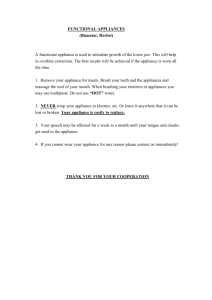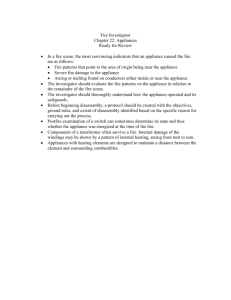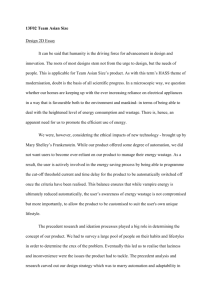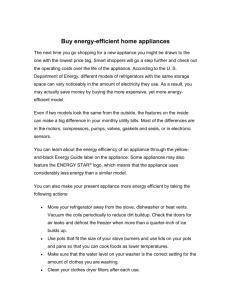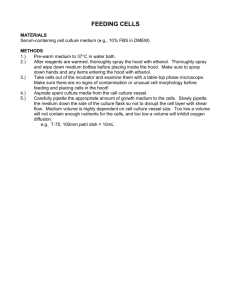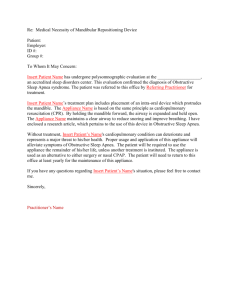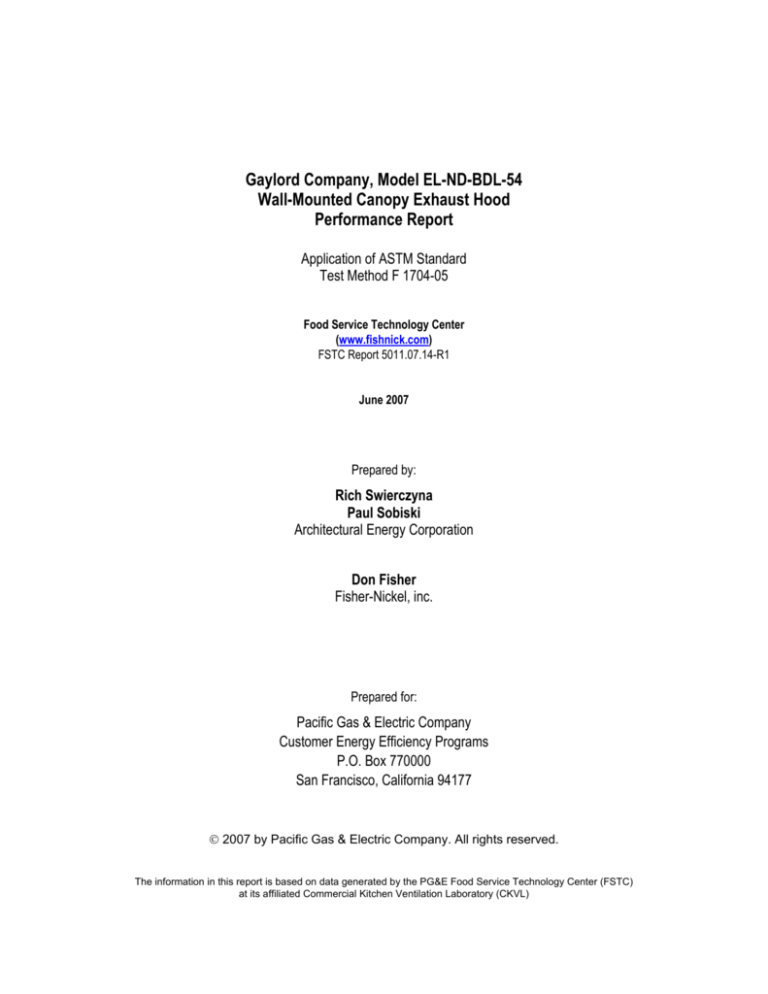
Gaylord Company, Model EL-ND-BDL-54
Wall-Mounted Canopy Exhaust Hood
Performance Report
Application of ASTM Standard
Test Method F 1704-05
Food Service Technology Center
(www.fishnick.com)
FSTC Report 5011.07.14-R1
June 2007
Prepared by:
Rich Swierczyna
Paul Sobiski
Architectural Energy Corporation
Don Fisher
Fisher-Nickel, inc.
Prepared for:
Pacific Gas & Electric Company
Customer Energy Efficiency Programs
P.O. Box 770000
San Francisco, California 94177
2007 by Pacific Gas & Electric Company. All rights reserved.
The information in this report is based on data generated by the PG&E Food Service Technology Center (FSTC)
at its affiliated Commercial Kitchen Ventilation Laboratory (CKVL)
Scope and Application of ASTM 1704, Standard Test Method for Capture and Containment Performance of
Commercial Kitchen Exhaust Ventilation Systems
The capture and containment exhaust air flow rates for the 10-foot wall canopy exhaust hood were determined under controlled laboratory conditions. The
makeup air was supplied at low velocity (less than 60 ft/min) through floor-mounted, displacement diffusers along the wall opposite the front face of the
hood. Appliances were positioned to maximize hood overhang and minimize the gap between the appliance and rear wall. The repeatability/accuracy of
the reported values is considered to be ± 5% (e.g., ± 100 cfm at 2000 cfm).
The hood under test was configured with manufacturer-specified hood features (e.g., hood height and depth and/or volume of hood reservoir, number of
duct collars, location and size of duct collars, effluent plume containment features or technologies) and manufacturer-specified installation options (e.g.,
side panels, back wall, rear seal) over the specified appliances operating under simulated cooking conditions. The common denominator for the different
styles and configurations of wall-canopy hoods tested by the PG&E Food Service Technology Center is the 10-foot hood length over a standardized
appliance challenge (i.e., heavy-, medium-, light-, and mixed-duty appliance lines). The specifications of the hood and its installation configuration over
each appliance line are detailed within the report.
The laboratory test setup was not intended to replicate a real-world installation of this hood where greater exhaust airflows may be required for the capture
and containment of the cooking effluent. The objective of this ASTM 1704 testing was to characterize capture and containment performance of an exhaust
hood in combination with the specified options within a controlled laboratory environment. The data in this report should not be used as the basis for
design exhaust rates and specifications. Design exhaust rates must recognize UL710 safety listings, utilize the knowledge and experience of the designer
with respect to the actual cooking operation, and compensate for the dynamics of a real-world kitchen.
Policy on the Use of Food Service Technology Center Test Results
FSTC’s technical research reports and publications are protected under U.S. and international copyright laws. In the event that FSTC data are to be
reported, quoted, or referred to in any way in publications, papers, brochures, advertising, or any other publicly available documents, the rules of copyright
must be strictly followed, including written permission from Fisher-Nickel, inc. in advance and proper attribution to the PG&E Food Service Technology
Center. In any such publication, sufficient text must be excerpted or quoted so as to give full and fair representation of findings as reported in the original
documentation from the FSTC. Reference to specific products or manufacturers is not an endorsement of that product or manufacturer by Fisher-Nickel,
inc., the Food Service Technology Center or Pacific Gas and Electric Company.
Disclaimer
Fisher-Nickel, inc. (FNi) and Pacific Gas and Electric Company (PG&E) make no warranty or representation, expressed or implied, and assume no liability
for any information, product or process on which it reports. In no event will FNi or PG&E be liable for any special, incidental, consequential, indirect or
similar damages, including but not limited to lost profits, lost market share, lost savings, lost data, increased cost of production, or any other damages
arising out of the use of the data or the interpretation of the data presented in this report.
Retention of this consulting firm by PG&E to develop this report does not constitute endorsement by PG&E for any work performed other than that
specified in the scope of this project.
Legal Notice
This report was prepared as a result of work sponsored by the California Public Utilities Commission (Commission). It does not necessarily represent the
views of the Commission, its employees, or the State of California. The Commission, the State of California, its employees, contractors, and
subcontractors make no warranty, express or implied, and assume no legal liability for the information in this report; nor does any party represent that the
use of this information will not infringe upon privately owned rights. This report has not been approved or disapproved by the Commission nor has the
Commission passed upon the accuracy or adequacy of the information in this report.
Revision History
Revision num.
Date
Description
Author(s)
0
July 2007
Initial release
Rich Swierczyna / Paul Sobiski / Don Fisher
1
December 2012
Updated report content to reflect changes in hoo Rich Swierczyna
model number EL-ND-BDL-54 was
XG-UV-ND-BDL-54
Contents
Page
Objective and Scope
1
Equipment
1
Test Protocol
6
Appliance and Hood Configuration Test Matrix
8
Results and Discussion
13
Summary and Conclusions
19
References
21
Appendix A – Gaylord EL-ND-BDL-54 Hood Drawing
22
Objectives and Scope
This report summarizes the results of performance testing a Gaylord Industries, Model EL-NDBDL-54 Exhaust Hood with ultraviolet (UV) filtration at the Commercial Kitchen Ventilation
Laboratory within the scope of the PG&E Food Service Technology Center program. The
objectives were to:
(1) Evaluate the capture and containment performance of this exhaust only, wall-mounted
canopy hood when challenged with light-, medium-, heavy-, and mixed-duty appliances
under the controlled conditions of the ASTM Standard Test Method F-1704 [Ref 1].
(2) Measure and report the pressure drop across the hood as a function of airflow.
(3) Measure and report the filter velocity profile across the length of the hood.
Equipment
Hood Specifications
The Gaylord EL-ND-BDL-54 canopy hood with UV filtration measured 10 feet wide by 4.5 feet
deep by 2.5 feet high and was mounted to a transparent back wall. A 3-inch standoff behind the
back panel was incorporated within the depth of the hood. The filter bank opening measured 11.9
square feet, 120 inches by 15.5 inches with two 4.5-inch blank-offs located on each side of the
center filter. The filter bank held seven filters. The hood plenum was exhausted through two
exhaust collars. The centers of both collars were located 11.0 inches from the rear of the hood.
The 7.0-inch wide by 10.0-inch deep left hand collar was located 30.0 inches from the side, and
the 13.0-inches wide by 10.0-inches deep right hand collar was located 30.0 inches from the side.
The collars were connected to the lab’s exhaust ductwork by a pant-leg type transition. The back
panel tapered directly from the bottom of the filter bank, 8.0 inches above the lower edge of the
hood, to the vertical wall, 3.0 inches above the lower edge. The grease cup and grease trough
were located behind the tapered panel below the filter bank. The front lower edge of the hood
was located at 78.0 inches above the finished floor. The hood was equipped with a 6.3-inch
internal flange along the entire front edge, which consisted of a 5.8-inch horizontal flange, and a
1.3-inch piece bent at 60 degrees. There was a 1-inch flange along each side. The hood setup
over a heavy-duty broiler line is shown in Figure 1.
FSTC Report 5011.07.14
June 2007
1
Figure 1. Gaylord PG-ND-BDL-54 Wall-Mounted Canopy Hood Test Setup (Note Transparent Back
Wall and Sides of Hood)
Filter Specifications
The hood was equipped with seven 17.5 -inch high by 15.5-inch wide by 2.5-inch thick stainless
steel baffle-type grease filters. Sample filters are shown in Figure 2.
Figure 2. Baffle Type Hood Filters
FSTC Report 5011.07.14
June 2007
2
Air Baffles
Listed air baffles were added behind the filters to redirect the air flow over specific appliances
and at specific lengths of the hood. Each air baffle was placed behind the baffle filters. The large
size air baffle measured 40.0 inches wide and 12.7 inches high overall. The medium small size
air baffle measured 36.0 inches wide and 7.2 inches high overall. Each air baffle had a 0.6-inch
section that was bent at a 45-degree angle and led-into the hood at the top of filter. The air
baffles are shown in Figure 3.
Figure 3. Large and Medium Size Air Baffles
FSTC Report 5011.07.14
June 2007
3
Side Panel Configuration
Partial side panels were used in seven capture and containment evaluations. Both the 48-inch by
48-inch by 45 degree and 36-inch by 36-inch by 45 degree side panels were evaluated with the
three charbroiler line. It was found that the larger side panel provided no improvement in hood
performance over the smaller side panel. The side panels were tested on both the inside and
outside of the lower edge of the hood, and no performance improvements were found for the
inside placement. All subsequent tests were conducted with the smaller panels installed on the
outside edge of the hood. A photograph with and without the 36-inch by 36-inch by 45 degree
side panels installed on the three-broiler cook line, along with a dimensional drawing, is shown
in Figure 4.
36in.
36in.
45°
18in.
36-in. x 36-in.
Side Panel
Figure 4. Side View with and without 36-inch x 36-inch Side Panels
Cooking Appliances
The appliances used to challenge this wall-mounted canopy hood were full-size electric ovens
(light-duty category), 2-vat high-efficiency gas fryers, a three-foot griddle (medium-duty) and 3foot underfired gas broilers (heavy-duty). For each setup, the appliances were operated under
simulated heavy-load cooking conditions established by a recent ASHRAE research project [Ref
2] based on the heavy load testing per the ASTM Standard Test Methods for appliances [Ref
5,6,7,8]. The cooking appliance specifications are listed in Table 1.
FSTC Report 5011.07.14
June 2007
4
Table 1 Cooking Appliance Specifications
3-Ft. Gas
Charbroiler
Full-Size Electric
Convection Oven
2-Vat Gas Fryer
3-Ft. Gas
Griddle
96,000 Btu/h
12.1 kW
160,000 Btu/h
90,000 Btu/h
5.0 sq. in.
8.6 cu. ft
Two 50 lb. vats
9.35 sq. ft.
Height
37.0 in.
57.3 in.
45.3 in.
37.0 in.
Width
34.0 in.
40.0 in.
31.3 in.
36.0 in.
Depth
31 in.
41/38/42 in.
28 in.
37 in.
Rated Input
Capacity
Hood/Appliance Overhang Relationship
The appliance lines were positioned in a “pushed back” condition with a minimum distance
between the backwall and the rear of the appliance (i.e., rear gap), while allowing enough space
for utility connections. Figure 5 illustrates the relationship between front overhang and rear gap.
Table 2 shows the actual dimensions of front overhang and rear gap in the “pushed back”
condition. Ovens remained in the 12.0-inch overhang position for all tests, as this was also the
position of maximum “push back” and minimum rear gap.
Front
12.0in.
Overhang
Rear
10.6
Gap
Figure 5. Relationship between Front Overhang and Rear Gap
FSTC Report 5011.07.14
June 2007
5
Table 2 Hood/Appliance Overhang Relationships
3-Ft. Gas Broiler
Full-Size Electric
Convection Oven
2-Vat Gas Fryer
3-Ft Gas Griddle
Front Overhang to Appliance [in.]
18
12
22
12
Rear of Appliance to Backwall [in.]
5
1
4
5
Test Protocol
Capture & Containment Testing
"Hood capture and containment" is defined in ASTM F1704-05, Capture and containment
performance of commercial kitchen exhaust ventilation systems, as "the ability of the hood to
capture and contain grease laden cooking vapors, convective heat and other products of cooking
processes.” Hood capture refers to the products getting into the hood reservoir, while
containment refers to these products staying in the hood reservoir and not spilling out into the
space. "Minimum capture and containment" is defined as "the conditions of hood operation at
which the exhaust flow rate is just sufficient to capture and contain the products generated by the
appliance in idle and heavy load cooking conditions, or at any intermediate prescribed load
condition."
For each capture and containment (C&C) evaluation, the exhaust rate was reduced until spillage
of the plume was observed (using the airflow visualization techniques described below) at any
point along the perimeter of the hood. The exhaust rate was then increased in fine increments
until C&C was achieved. For most cases, single-test determinations were used to establish the
reported threshold of C&C. This threshold C&C rate was used for direct comparisons across
scenarios. In all evaluations, the replacement air was supplied from low velocity, floor-mounted
diffusers along the opposite wall (Figure 6). The introduction of replacement air from such
sources has been found to be optimum (i.e., the least disruptive) for the laboratory test setup
[Ref 3].
A walk-by protocol was introduced to simulate operator movement in the restaurant in the
vicinity of the hood during the cooking process. The procedure was used in the lab to emulate the
effect of operator disturbance on capture and containment. For this assessment, a researcher
walked a line 6 inches in front of the hood (18 inches in front of the appliances with a 12 inch
overhang) at a rate of 100 steps per minute. The exhaust air flow rate was then increased to
achieve capture and containment of the thermal plume under this dynamic challenge.
Airflow Visualization
The primary tools used for airflow visualization were schlieren and shadowgraph systems, which
visualize the refraction of light due to air density changes. Since the heat and effluent generated
by the cooking process change the air density above the equipment, the sensitive flow
visualization systems provide a graphic image of the thermal activity along the perimeter of the
hood. The front and left lower edges of the hood were monitored by schlieren systems located at
a height that was centered between the typical 36-inch appliance height and the 78-inch hood
FSTC Report 5011.07.14
June 2007
6
height. The right lower edge of the hood was monitored using a shadowgraph system, located at
the same height as the hood edge. Figure 6 shows a plan view of the laboratory with the relative
positions of the hood and flow visualization instruments.
Lab Exhaust Duct
Pant-Leg Transition
81 in x 16 in x 12 in high
37.00
48.00
Hood Collars
91.00
Backwall
43.0
10 ft x 4.5 ft x 2.5 ft
Canopy Hood
Schlieren
Schlieren
Optics Box
Shadowgraph
Optics Box
185.00
Supply Diffuser Wall
Figure 6. Plan View of Lab During Hood Evaluation
The airflow measurements in the laboratory are in compliance with the AMCA 210/ASHRAE 51
Standard [Ref 4]. The error on the airflow rate measurement is less than 2%. The repeatability of
capture and containment determinations is typically within 5%.
Static Pressure Differential
The static pressure difference was measured between the laboratory and the top of the pant-leg
transition connecting the two exhaust collars to the hood, and at the hood plenum. The plenum
pressure was taken at center-front of hood plenum above filter bank, 2 inches above the UV
modules and 2 inches below top of hood. The location of pressure port for the top of the pant-leg
transition was at the center of the rear of the 16-inch by 16-inch by 2-inch collar above the
transition. The static pressure probe was located approximately 4-inches inside the transition
collar wall and was measured with a 4-inch by 2-inch right-angle static pressure probe. The
pressures were taken for five exhaust flow rates (1500, 2000, 2500, 3000, and 3300 cfm).
Filter Face Velocity Profile
The filter face velocity was measured with a 4-inch diameter, rotating vane anemometer (RVA)
flush against each filter. One-minute average readings were recorded for each filter traverse. The
profiles were taken for two exhaust airflow rates, 2000 and 3000 cfm.
FSTC Report 5011.07.14
June 2007
7
Appliance and Hood Configuration Test Matrix
The performance of the Gaylord EL-ND-BDL-54 hood was evaluated for 12 test conditions.
Generally, each appliance line configuration was evaluated in a best practice “pushed back”
condition with and without side panels. In addition, one test with the broiler challenge included a
seal between the rear of the appliances and the wall. Another additional test was performed on
the mixed appliance line to evaluate hood performance under a dynamic walk-by challenge. In
this case, the exhaust rate was increased to achieve capture and containment under the disruption
caused by operator movement. The following test matrices present the details of the test setups
for the respective appliance lines. Each test condition is sequentially numbered for reference to
the reported data.
FSTC Report 5011.07.14
June 2007
8
Underfired Gas Broiler (Heavy-Duty) Test Matrix
The heavy-duty challenge was comprised of three 3-foot, gas underfired broilers. The front
overhang was 18.0 inches in the pushed back condition and resulted in a rear gap of 5.0 inches.
The hood was tested for each appliance location with and without side panels, in a static (no
operator movement) condition. With the broilers in this configuration and the side panels
installed, an additional evaluation was done with the 5.0-inch rear gap sealed between the
broilers and the back wall at the height of the top of the appliance cabinet (Test 3). The test
matrix for the heavy-duty broilers is shown in Table 3 and the setup illustrated in Figure 7.
Table 3. Underfired Gas Broiler (Heavy-Duty) Test Matrix
Test
#
1
2
3
LH
Appliance
LH
Appliance
Effective
Front
Overhang1
[in.]
LH
Appliance
Effective
Rear Gap
[in.]
CTR
Appliance
CTR
Appliance
Effective
Front
Overhang
[in.]
CTR
Appliance
Effective
Rear Gap
[in.]
RH
Appliance
RH
Appliance
Effective
Front
Overhang1
[in.]
RH
Appliance
Effective
Rear Gap
[in.]
Side
Panels
Side
Overhang
[in.]
Broiler
Broiler
Broiler
18
18
18
5
5
5
Broiler
Broiler
Broiler
18
18
18
5
5
5
Broiler
Broiler
Broiler
18
18
18
5
5
5
Without
With
6
6
6
With Side
Panels &
Rear Seal
Figure 7. Heavy-Duty Underfired Gas Broiler Line
FSTC Report 5011.07.14
June 2007
9
Gas Fryer (Medium-Duty) Test Matrix
The medium-duty test matrix consisted of three 2-vat gas fryers (6 vats total). The front overhang
was 22.0 inches and resulted in a rear gap of 4.0 inches. The hood was tested with and without
side panels, in a static (no operator movement) condition. The test matrix for the medium-duty
fryers is shown in Table 4 and the setup illustrated in Figure 8.
Table 4. Fryer (Medium-Duty Appliance) Test Matrix
Test
#
4
5
LH
Appliance
LH
Appliance
Effective
Front
Overhang1
[in.]
LH
Appliance
Effective
Rear Gap
[in.]
CTR
Appliance
CTR
Appliance
Effective
Front
Overhang
[in.]
CTR
Appliance
Effective
Rear Gap
[in.]
RH
Appliance
RH
Appliance
Effective
Front
Overhang1
[in.]
RH
Appliance
Effective
Rear Gap
[in.]
Side
Panels
Side
Overhang
[in.]
2-Vat
Fryer
2-Vat
Fryer
22
4
22
4
4
Without
6
4
22
4
2-Vat
Fryer
2-Vat
Fryer
22
22
2-Vat
Fryer
2-Vat
Fryer
22
4
With
6
Figure 8. Medium-Duty Gas Fryer Line
FSTC Report 5011.07.14
June 2007
10
Full-Size Electric Convection Oven (Light-Duty) Test Matrix
The light-duty test matrix consisted of one full-size electric convection oven and two full size
gas convection ovens. As the electric oven idled, the gas ovens maintained the same operating
temperature, and then the burners were turned off during the capture and containment evaluation
[Ref 2]. The front overhang was 12.0 inches. In this configuration, the left oven had 4.0 inches
between the convection motor and the backwall, the center oven had 1.0 inch between the motor
and the backwall, and the right oven was flush against the backwall. The rear gap was measured
from the rear of the convection fan motor to the back wall, except for the right oven that had its
motor shrouded. The hood was tested with and without side panels, in a static (no operator
movement) condition. The test matrix for the full-size ovens is shown in Table 5 and the setup
illustrated in Figure 9.
Table 5. Full-Size Convection Oven (Light-Duty) Test Matrix
Test
#
6
7
LH
Appliance
LH
Appliance
Effective
Front
Overhang1
[in.]
LH
Appliance
Effective
Rear Gap
[in.]
CTR
Appliance
CTR
Appliance
Effective
Front
Overhang
[in.]
CTR
Appliance
Effective
Rear Gap
[in.]
RH
Appliance
RH
Appliance
Effective
Front
Overhang1
[in.]
RH
Appliance
Effective
Rear Gap
[in.]
Side
Panels
Side
Overhang
[in.]
Oven
Oven
12
12
4
4
Oven
Oven
12
12
1
1
Oven
Oven
12
12
0
0
Without
With
0
0
Figure 9. Light-Duty Full Size Convection Oven Line
FSTC Report 5011.07.14
June 2007
11
2-Vat Fryer/Charbroiler or Griddle/Convection Oven (Combination-Duty) Test Matrix
The combination duty test matrix consisted of the 2-vat gas fryer in the left position, the 3-foot
gas underfired broiler in the center position and the full-size electric convection oven in the right
position. The performance of the hood was evaluated with and without side panels, in a static (no
operator movement) condition, except for Test 10. For this test, hood performance was evaluated
using a walk-by protocol. In Test 11 and 12, the broiler was replaced with a gas griddle. The test
matrix for the combination-duty appliance line is shown in Table 6 and the setup illustrated in
Figure 10.
Table 6. Fryer/Broiler/Convection Oven (Combination Duty) Test Matrix
Test
#
8
9
102
11
12
2
LH
Appliance
LH
Appliance
Effective
Front
Overhang1
[in.]
LH
Appliance
Effective
Rear Gap
[in.]
CTR
Appliance
CTR
Appliance
Effective
Front
Overhang
[in.]
CTR
Appliance
Effective
Rear Gap
[in.]
RH
Appliance
RH
Appliance
Effective
Front
Overhang1
[in.]
RH
Appliance
Effective
Rear Gap
[in.]
Side
Panels
Side
Overhang
[in.]
2-Vat
Fryer
2-Vat
Fryer
2-Vat
Fryer
2-Vat
Fryer
2-Vat
Fryer
22
4
Broiler
18
5
Oven
12
1
Without
6
22
4
Broiler
18
5
Oven
12
1
With
6
22
4
Broiler
18
5
Oven
12
1
With
6
22
4
Griddle
12
5
Oven
12
1
Without
6
22
4
Griddle
12
5
Oven
12
1
With
6
Test condition was conducted with “walk-by” protocol.
Figure 10. Fryer/Charbroiler/Convection Oven Appliance Line
FSTC Report 5011.07.14
June 2007
12
Results and Discussion
The capture and containment (C&C) results are presented below for the different appliance-line
configurations.
Broiler (Heavy-Duty) Testing
The results of the gas broiler-line capture and containment testing are presented in Table 7. It
was found that the exhaust rate required to capture and contain the thermal challenge from three
broilers was 2700 cfm. When the 36-inch by 36-inch by 45 degree side panels were added to this
condition, the threshold airflow rate for C&C was reduced to 2600 cfm. When the 48-inch by 48inch by 45 degree side panels were tested, the C&C exhaust rate was also 2600 cfm. When the
rear gap between the broiler cabinet and backwall was sealed, the C&C exhaust rate was reduced
further to 2200 cfm (220 cfm/ft).
Table 7. Capture and Containment Results for Charbroilers
Test
#
1
2
3
LH
Appliance
LH
Appliance
Effective
Front
Overhang1
[in.]
CTR
Appliance
CTR
Appliance
Effective
Front
Overhang
[in.]
RH
Appliance
RH
Appliance
Effective
Front
Overhang1
[in.]
Side
Panels
Side
Overhang
[in.]
C&C
Exhaust
Rate
[acfm]
C&C
Exhaust
Rate
[acfm/ft]
Charbroiler
Charbroiler
Charbroiler
18
18
18
Charbroiler
Charbroiler
Charbroiler
18
18
18
Charbroiler
Charbroiler
Charbroiler
18
18
18
Without
With
6
6
6
2700
2600
2200
270
260
220
With Side
Panels &
Rear Seal
Fryer (Medium-Duty) Testing
The results of the gas fryer capture and containment testing are presented in Table 8. It was
found that the exhaust rate required to capture and contain the three 2-vat fryers (6-vats total)
was 2400 cfm. The hood performed well in capturing and containing the strong thermal plume
from the fryers’ flue jetting up along the rear wall. However, when side panels were added to this
condition they helped to contain the flue products, and the exhaust rate dropped to 1600 cfm
(160 cfm/ft). Although the hood spilled in the rear corner without side panels, the hood with side
panels allowed the reservoir to fill and eventually spill at the front corner of the hood.
Table 8. Capture and Containment Results for Fryers
Test
#
4
5
LH
Appliance
LH
Appliance
Effective
Front
Overhang1
[in.]
CTR
Appliance
CTR
Appliance
Effective
Front
Overhang
[in.]
RH
Appliance
RH
Appliance
Effective
Front
Overhang1
[in.]
Side
Panels
Side
Overhang
[in.]
C&C
Exhaust
Rate
[acfm]
C&C
Exhaust
Rate
[acfm/ft]
2-Vat
Fryer
2-Vat
Fryer
22
2-Vat
Fryer
2-Vat
Fryer
22
2-Vat Fryer
22
Without
6
2400
240
22
2-Vat Fryer
22
With
6
1600
160
FSTC Report 5011.07.14
June 2007
22
13
Full-Size Convection Oven (Light Duty) Testing
The results of the full-size convection oven testing are presented in Table 9. It was found that the
exhaust rate required to capture and contain three full-size convection ovens with and without
side panels was 900 cfm (90 cfm/ft).
Table 9. Capture and Containment Results Full-Size Convection Ovens
Test
#
6
7
LH
Appliance
LH
Appliance
Effective
Front
Overhang1
[in.]
CTR
Appliance
CTR
Appliance
Effective
Front
Overhang
[in.]
RH
Appliance
RH
Appliance
Effective
Front
Overhang1
[in.]
Side
Panels
Side
Overhang
[in.]
C&C
Exhaust
Rate
[acfm]
C&C
Exhaust
Rate
[acfm/ft]
Oven
Oven
12
12
Oven
Oven
12
12
Oven
Oven
12
12
Without
With
0
0
900
900
90
90
Fryer/Broiler or Griddle/Convection Oven (Combination-Duty) Testing
The results for the 2-vat fryer/3-foot charbroiler/full-size convection oven capture and
containment tests are presented in Table 10. All evaluations were conducted at a static condition
except for test 10, which incorporated a walk-by protocol. Test 11 and 12 were conducted with a
griddle in place of the broiler.
The exhaust rate required to capture and contain a 2-vat fryer/3-foot broiler/full-size convection
oven cook line was 2200 cfm. If side panels were added to this pushed back condition, the
capture and containment exhaust rate dropped to 1900 cfm (190 cfm/ft). When the medium air
baffle was installed above the 2-vat fryer and the large air baffle above the oven, the capture and
containment exhaust rate was 2000 cfm without side panels and 1900 with side panels.
Table 10. Capture and Containment Results for 2-Vat Fryer / Charbroiler / Full-Size
Convection Oven Appliance Line
Test
#
8
9
102
11
12
2
LH
Appliance
LH
Appliance
Effective
Front
Overhang1
[in.]
CTR
Appliance
CTR
Appliance
Effective
Front
Overhang
[in.]
RH
Appliance
RH
Appliance
Effective
Front
Overhang1
[in.]
Side
Panels
Side
Overhang
[in.]
C&C
Exhaust
Rate
[acfm]
C&C
Exhaust
Rate
[acfm/ft]
2-Vat
Fryer
2-Vat
Fryer
2-Vat
Fryer
2-Vat
Fryer
2-Vat
Fryer
22
Charbroiler
18
Oven
12
Without
6
2200
220
22
Charbroiler
18
Oven
12
With
6
1900
190
22
Charbroiler
18
Oven
12
With
6
2600
260
22
Griddle
12
Oven
12
Without
6
1900
190
22
Griddle
12
Oven
12
With
6
1700
170
Test condition was conducted with “walk-by” protocol.
A walk-by evaluation was conducted for the combination duty line with side panels and without
air baffles. The increased exhaust flow rate required to capture and contain the dynamically
disturbed thermal plume was 2600 cfm (700 cfm higher than the static condition).
FSTC Report 5011.07.14
June 2007
14
The combination-duty appliance line was also evaluated with a griddle replacing the broiler in
the center position. Without side panels installed, the measured C&C exhaust rate was 1900 cfm.
With side panels added, the C&C exhaust rate was reduced to 1700 cfm (170 cfm/ft). If the
medium air baffle was installed above the oven, the capture and containment exhaust rate was
1900 cfm without side panels, and 1500 with side panels.
FSTC Report 5011.07.14
June 2007
15
Static Pressure Differential Measured at Exhaust Collar
The static pressure drop between the laboratory and the top of the pant-leg transition, between
the laboratory and at the hood plenum were measured for five exhaust flow rates. The pressure
drop to the top of the pant-leg transition ranged from 0.36 in. of water at 1500 cfm to 1.75 in. of
water at 3300 cfm; whereas the pressure drop to the hood plenum ranged from 0.15 in. of water
at 1500 cfm to 0.70 in. of water at 3300 cfm. The results are presented in Table 11.
Table 11. Hood Static Pressure Readings at Top of Pant-Leg Transition
and Hood Plenum
Exhaust Flow Rate
[acfm]
1500
2000
2500
3000
3300
Hood Static Pressure
at Top of Pant-Leg
Transition
[inches of water]
0.36
0.63
0.98
1.41
1.75
Hood Static Pressure
at Hood Plenum
[inches of water]
0.15
0.27
0.41
0.58
0.70
Figure 11 presents the static pressure at the top of the pant-leg transition and at the hood plenum
versus airflow curve. The transition added slightly over 1.0 in. of water pressure at 3300 cfm.
1.80
Top of Pant-Leg Transition
Hood Plenum
1.60
Static Pressure [in. of water]
1.40
1.20
1.00
0.80
0.60
0.40
0.20
0.00
0
500
1000
1500
2000
2500
3000
3500
Exhaust Airflow Rate [acfm]
Figure 11. Static Pressure Differential Measured at Top of Pant-Leg Transition and Hood Plenum
FSTC Report 5011.07.14
June 2007
16
Filter Face Velocity Testing
Filter face velocity readings were taken for each of the six filters at two exhaust flow rates. For
the 2000 cfm exhaust rate, the filter velocities ranged from 220 to 234. For the 3000 cfm exhaust
rate, the filter velocities ranged from 330 to 364 fpm. The data are presented in Table 12 and a
velocity profile is shown in Figure 12.
Table 12. Filter Face Velocity Readings
Exhaust
Flow
Rate
[acfm]
2000
3000
Left
Filter #1
Velocity
[fpm]
234
364
Filter #2
Velocity
[fpm]
229
357
Filter #3
Velocity
[fpm]
229
346
Filter #4
Velocity
[fpm]
220
350
Filter #5
Velocity
[fpm]
230
358
Filter #6
Velocity
[fpm]
230
339
Right
Filter #7
Velocity
[fpm]
220
330
Avg.
Filter
Velocity
[fpm]
227
349
Standard
Deviation
[fpm]
5
12
Standard
Deviation
[%]
2
3
400
2000 acfm
3000 acfm
350
Filter Face Velocity [fpm]
300
250
200
150
100
50
0
Left
Filter
Velocity
#1
Filter Velocity
#2
Filter Velocity
#3
Filter Velocity
#4
Filter Velocity
#5
Filter
Velocity
#6
Right
Filter
Velocity
#7
Figure 12. Filter Face Velocity Profiles
For both exhaust rates, the profiles show that the velocity was relatively flat and that condition is
reflected in the small ratio of standard deviation to average velocity (i.e., less than 3%). A slight
increase in velocity was seen near the two exhaust collars. The two exhaust collars kept the
velocity higher at the side filters and aided in capture and containment at the sides (typically the
weak point of the hood). For the 2000 cfm exhaust rate, the average filter velocity was 227 fpm.
The maximum velocity was 234 fpm and the minimum was 220 fpm. For the 3000 cfm rate, the
FSTC Report 5011.07.14
June 2007
17
average filter velocity was 349 fpm, with a maximum velocity of 364 fpm and a minimum
velocity of 330 fpm.
FSTC Report 5011.07.14
June 2007
18
Summary of Results and Conclusions
Figure 13 and Table 13 summarize the results for the capture and containment testing. The test
numbers in Figure 11 refer to the first column of Table 13 and associated test condition. An
immediate observation is the range in C&C airflow rates, from a low of 900 cfm (90 cfm/ft) to a
high of 2700 cfm (270 cfm/ft). The higher rates, above 2400 cfm (240 cfm/ft), were for the
heavy- and medium-duty appliance challenge (broilers and fryers) without side panels. This can
be compared to data for a generic 10-foot, wall canopy hood reported by an ASHRAE research
project [Ref 2] where the range for these two appliance categories without side panels was from
2400 cfm (240 cfm/ft) to 4400 cfm (440 cfm/ft).
The dramatic benefit of side panels was demonstrated for nearly all appliance combinations
tested. The 36-inch x 36-inch x 45-degree panel installed on both ends of the 10-foot, wall
mounted Gaylord hood provided the more stable capture and containment flow rates. The
addition of side panels to the three broiler line reduced the C&C flow rate to 2600 cfm. When a
rear shield was added (between the rear of the appliance and the back wall), the C&C flow rate
dropped to 2200 cfm (220 cfm/ft). Based on testing experience of the CKV research team and
data from the ASHRAE study [Ref 2], this is considered to be a very low threshold of C&C for a
heavy-duty appliance challenge. The three 2-vat fryer line benefited greatly from the
stabilization of adding side panels. The side panels contained the flue products near the rear
corner of the hood and reduced the capture and containment rate from 2400 to 1600 cfm.
The multi-duty line was incorporated with the test matrix to reflect a cooking equipment
challenge in a real-world, casual dining kitchen. In this case, the C&C rate was 2200 cfm (220
cfm/ft) without side panels. When the side panels were installed, the C&C flow rate dropped to
1900 cfm (190 cfm/ft). Under the dynamic walk-by condition, the C&C exhaust rate increased to
2600 cfm (260 cfm/ft). When the griddle was substituted for the broiler under static test
conditions, a C&C rate of 1900 cfm (190 cfm/ft) was recorded without side panels and 1700
(170 cfm/ft) with side panels..
The static pressure differential was measured at the top of the pant-leg transition and at the hood
plenum. At the top of the pant-leg transition, the static pressure varied from 0.36 to 1.41 in. of
water between 1500 to 3000 cfm of exhaust airflow. In the hood plenum, the pressure varied
from 0.15 to 0.58 in. of water between 1500 to 3000 cfm of exhaust airflow. At 2500 cfm (250
cfm/ft) the static pressure at the top of the pant-leg transition was 0.57 in. of water higher than in
the hood plenum.
The measured filter velocities across the length of the exhaust hood showed a very flat profile
due to the two exhaust collars and are evident in the calculation of the standard deviation of 2%
and 3% at 2000 cfm and 3000 cfm, respectively.
FSTC Report 5011.07.14
June 2007
19
Table 13. Summary of Capture and Containment Results
LH
Appliance
LH
Appliance
Effective
Front
Overhang1
[in.]
LH
Appliance
Effective
Rear Gap
[in.]
CTR
Appliance
CTR
Appliance
Effective
Front
Overhang1
[in.]
CTR
Appliance
Effective
Rear Gap
[in.]
RH
Appliance
RH
Appliance
Effective
Front
Overhang1
[in.]
RH
Appliance
Effective
Rear Gap
[in.]
Side
Panels
Side
Overhang
[in.]
C&C
Exhaust
Rate
[cfm]
1
2
3
Charbroiler
Charbroiler
Charbroiler
18
18
18
5
5
5
Charbroiler
Charbroiler
Charbroiler
18
18
18
5
5
5
Charbroiler
Charbroiler
Charbroiler
18
18
18
5
5
5
Without
With
6
6
6
2700
2600
2200
4
2-Vat
Fryer
2-Vat
Fryer
22
4
22
4
4
Without
6
2400
4
22
4
2-Vat
Fryer
2-Vat
Fryer
22
22
2-Vat
Fryer
2-Vat
Fryer
22
4
With
6
1600
Oven
Oven
12
12
4
4
Oven
Oven
12
12
1
1
Oven
Oven
12
12
0
0
Without
With
0
0
900
900
2-Vat
22
4
Charbroiler
18
Fryer
9
2-Vat
22
4
Charbroiler
18
Fryer
102
2-Vat
22
4
Charbroiler
18
Fryer
11
2-Vat
22
4
Griddle
12
Fryer
12
2-Vat
22
4
Griddle
12
Fryer
1
Front overhang measured from front of hood to front of appliance
2
Test condition was conducted with “walk-by” protocol.
5
Oven
12
1
Without
6
2200
5
Oven
12
1
With
6
1900
5
Oven
12
1
With
6
2600
5
Oven
12
1
Without
6
1900
5
Oven
12
1
With
6
1700
Test
#
5
6
7
8
With Side
Panels &
Rear Seal
3000
2700
Capture & Containment Exhaust Flow Rate [acfm]
2600
2600
2500
2400
2200
2200
2000
1900
1900
1700
1600
1500
1000
900
900
6
7
500
0
1
2
3
4
5
8
9
10
11
12
Test Number
Figure 13. Summary of Capture and Containment Results
FSTC Report 5011.07.14
June 2007
20
References
1. ASTM 2005. ASTM Designation F1704-99, Capture and containment performance of
commercial kitchen exhaust ventilation systems. West Conshohocken, PA.
2. Swierczyna, R.T., P.A. Sobiski, D. Fisher. 2005. 1202-RP Effect of appliance diversity and
position on commercial kitchen hood performance. ASHRAE, Atlanta, GA.
3. Brohard, G., D.R. Fisher PE, V.A. Smith PE, R.T. Swierczyna, P.A. Sobiski. 2003. Makeup
air effects on kitchen exhaust hood performance. California Energy Commission,
Sacramento, CA.
4. Air Movement and Control Association, Inc. and American Society of Heating,
Refrigeration, and Air Conditioning Engineers, Inc. Laboratory methods of testing fans for
rating. AMCA Standard 210/ASHRAE Standard 51, Arlington Heights, IL and Atlanta, GA.
5. ASTM 2005. ASTM Designation F1496, Standard test method for performance of
convection ovens. West Conshohocken, PA.
6. ASTM 2005. ASTM Designation F1361, Standard test method for performance of open deep
fat fryers. West Conshohocken, PA.
7. ASTM 2003. ASTM Designation F1275, Standard test method for performance of griddles.
West Conshohocken, PA.
8. ASTM 2003. ASTM Designation F1695, Standard test method for performance of underfired
broilers. West Conshohocken, PA.
FSTC Report 5011.07.14
June 2007
21
Appendix A: Gaylord Model EL-ND-BDL-54 Hood Drawing
FSTC Report 5011.07.14
June 2007
22

